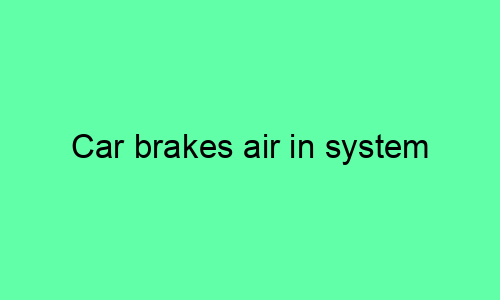## Car Brakes Air in System: Causes, Symptoms, and Repair
### Causes of Air in Car Brake System
The presence of air in a car’s brake system can be caused by various factors, including:
– **Leaking Brake Lines:** Damaged or corroded brake lines can allow air to enter the system, especially if the lines are located close to the ground or exposed to road debris.
– **Loose Brake Calipers or Wheel Cylinders:** Loose or misaligned brake calipers or wheel cylinders can create gaps where air can leak into the system.
– **Improper Brake Fluid Replacement:** When brake fluid is replaced, air can be introduced if the master cylinder or brake lines are not properly bled.
– **Overfilled Brake Fluid Reservoir:** An overfilled brake fluid reservoir can cause the brake fluid to overflow when the brakes are applied, creating air bubbles in the system.
– **Damaged or Cracked Brake Master Cylinder:** A damaged or cracked brake master cylinder can allow air to enter the system, especially if the crack is located on the reservoir side.
### Symptoms of Air in Car Brake System
The presence of air in a car’s brake system can manifest itself through the following symptoms:
– **Spongy Brake Pedal:** A soft or spongy brake pedal that requires more effort to depress indicates the presence of air in the system.
– **Brake Pedal Pulsation:** Pulsation or vibration in the brake pedal while braking is a sign of air in the brake lines.
– **Reduced Braking Power:** Air in the system can lead to decreased braking power, making it harder to stop the vehicle effectively.
– **Brake Fluid Leaks:** Air leaks in the brake system can also result in brake fluid leaks, which can further compromise braking performance.
– **ABS Activation Under Normal Braking:** If the ABS system activates when the brakes are applied under normal conditions, it may be an indication of air in the brake system.
### Diagnosing Air in Car Brake System
Diagnosing the presence of air in a car’s brake system involves a visual inspection, brake pedal test, and system bleeding.
– **Visual Inspection:** Check for any visible leaks or damage to brake lines, calipers, or wheel cylinders. Inspect the brake fluid reservoir for signs of overfilling or fluid leaks.
– **Brake Pedal Test:** Pump the brake pedal several times with the engine off. A spongy or pulsating pedal indicates the presence of air.
– **System Bleeding:** Using a brake bleeder kit, connect a hose to the bleeder screw on each brake caliper or wheel cylinder. Open the bleeder screw slightly and pump the brake pedal to force any trapped air out of the system. Close the bleeder screw when clear brake fluid starts to flow without air bubbles.
### Repairing Air in Car Brake System
To repair a car’s brake system with air, it is necessary to identify and fix the underlying cause of the air leak.
– **Replace Leaking Brake Lines:** If the brake lines are leaking, they must be replaced with new ones.
– **Tighten Loose Brake Calipers or Wheel Cylinders:** Ensure that brake calipers and wheel cylinders are properly tightened and aligned to prevent air leaks.
– **Bleed the Brake System:** Use a brake bleeder kit to remove any trapped air from the system. Start with the caliper or wheel cylinder furthest from the master cylinder and work your way towards the master cylinder, bleeding each caliper or wheel cylinder in turn.
– **Reinstall the Brake Master Cylinder:** If the brake master cylinder is damaged or cracked, it must be replaced. Reinstall the new master cylinder and bleed the system thoroughly.
### Prevention of Air in Car Brake System
Preventing air from entering a car’s brake system involves proper maintenance and servicing.
– **Regular Brake Fluid Flush:** Flushing the brake fluid regularly helps remove impurities and moisture that can lead to corrosion and air leaks.
– **Thorough Brake Service:** Inspecting and servicing brakes periodically helps identify potential problems and prevents air from entering the system.
– **Avoid Overfilling the Brake Fluid Reservoir:** Follow the manufacturer’s recommendations for the correct brake fluid level and avoid overfilling the reservoir.
– **Use High-Quality Brake Fluid:** Using high-quality DOT-approved brake fluid helps prevent corrosion and air buildup in the system.






